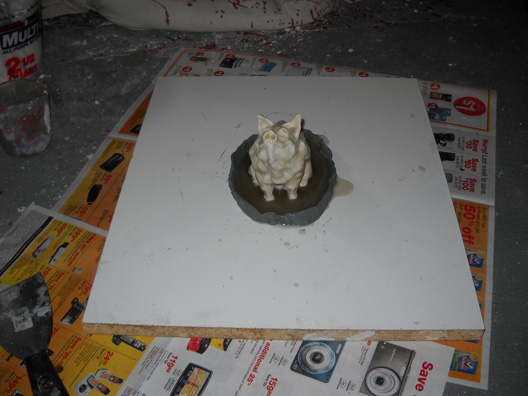Bronze Casting -
Step 3
Making the Mold: First Layer

Different rubbers can be used for making the inner mold. Silicone, latex, and urethane. All have advantages and disadvantages. Silicone is often used for big molds but tends to make bubbles, and so for the best quality work you normally need vacuum equipment to "degas" the liquid. Silicone rubber formulations are similar to what you get in 100 % silicone calking guns and some sculptors have used caulking as a "poor man's" mold making material. An experiment with that method was not particularly satisfactory, and a personal opinion is that it is better to use rubber formulations specifically created for mold making.
Latex is also used because it can be used on delicate or fragile models. But it is relatively expensive and to get a thick mold to hold its form requires multiple layering. So the process of making a latex inner mold can takes days at a minimum or sometimes weeks. Latex also requires addition of a catalyst which usually must be weighed out. How the latex cures depends on how well you weighed the catalyst, and so you need a decent scale capable of weighing small amounts. If you want something safe enough for life casting (i. e., making a mold directly on a person's parts) you will use a version of latex that has been formulated specifically for life modeling. Urethanes are not intended for life modeling as the isocyanate compounds are not what you want on your skin or to breath in, and so you want to use them where you have good ventilation.
The advantage of urethanes is the ease of use. Urethanes comes in two parts, A and B, commonsensically labeled parts A and B. You simply pour the two parts into separate containers so you have equal volumes of each. Graduated plastic cups or pails work fine, thank you. Then you pour the two parts together in a single container and mix them well with a paint stirrer or similar spatula. You then end up with a liquid which can be poured or brushed onto the surface of the model which on curing forms a nice rubber layer. Urethane also cures in a convenient time - 30 minutes to an hour - and gives you ample time to apply the coat.
Before you add the first coating of any rubber, the model needs to be coated with a mold release agent. Today you can buy releases in spray bottles and they are usually a solution of some silicone oil. In older days the mold releases were often vegetable oils or vaseline. Unless you have a special self-demolding rubber and if you forget the mold release, your mold will tear apart when you try to remove the model.
The model shown here is being coated with a "pourable" urethane of low viscosity - pourable, although it was brushed on. For the first coat you want all the fine details filled in. So it can be thin and runny at this stage.
We mentioned that we used a clay "dam" (not to be confused with using damn clay) to keep the rubber from spreading to much. But you should also notice the dam is fairly full. That is due to using a bit too much of the rubber. At this stage the urethane is of low viscosity and so you only coat a thin layer on the model.
Truly skilled molders often eschew the dam (referring to it as a "damn dam"). By using just enough rubber so it spreads a bit past the model but not too far and stops on its own, the mold makers make sure they are being economical - something that is important in art as in anything else. The thickness on the first coat is determined by the viscosity of the formulation and anything that runs off is just wasted rubber.
The cure times vary but for this brand of rubber, it took about an hour and a half - longer than it should have been probably because it wasn't quite 1 part A to 1 part B (the amounts were simply eyeballed). But after waiting it did become rubbery with a measure of tackiness. More careful measurement would have reduced the time to about 45 minutes and made a more firmer final mold. But the next layer requires an extra step for which great caution should be exercised.